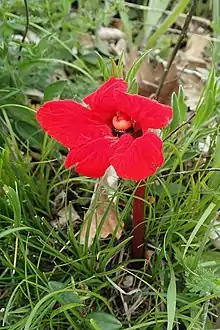| Phelypaea | |
|---|---|
 | |
| Phelypaea tournefortii | |
| Scientific classification | |
| Kingdom: | Plantae |
| Clade: | Tracheophytes |
| Clade: | Angiosperms |
| Clade: | Eudicots |
| Clade: | Asterids |
| Order: | Lamiales |
| Family: | Orobanchaceae |
| Tribe: | Orobancheae |
| Genus: | Phelypaea Tourn. ex L.[1] |
| Species | |
|
See text | |
| Synonyms[2] | |
| |
Phelypaea is a genus of flowering plants in the broomrape family Orobanchaceae, native to the Balkans, Greece, Crimea, the Caucasus region, Anatolia, the Levant, Iraq and Iran. They are root parasites which cannot conduct photosynthesis and are only seen above ground when flowering.[3]
Species
Currently accepted species include:[2]
- Phelypaea boissieri (Reut.) Stapf
- Phelypaea coccinea (M.Bieb.) Poir.
- Phelypaea tournefortii Desf.
References
- ↑ Opera Var.: 237 (1758)
- 1 2 "Phelypaea Tourn. ex L." Plants of the World Online. Board of Trustees of the Royal Botanic Gardens, Kew. 2017. Retrieved 25 July 2020.
- ↑ Piwowarczyk, Renata; Ochmian, Ireneusz; Lachowicz, Sabina; Kapusta, Ireneusz; Sotek, Zofia (2020). "Phytochemical and Bioactive Properties of Phelypaea tournefortii – Effect of Parasitic Lifestyle and Environmental Factors". Acta Universitatis Cibiniensis. Series E: Food Technology. 24: 113–128. doi:10.2478/aucft-2020-0010. S2CID 220368482.
This article is issued from Wikipedia. The text is licensed under Creative Commons - Attribution - Sharealike. Additional terms may apply for the media files.